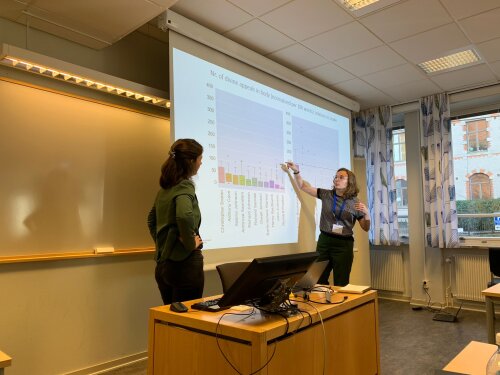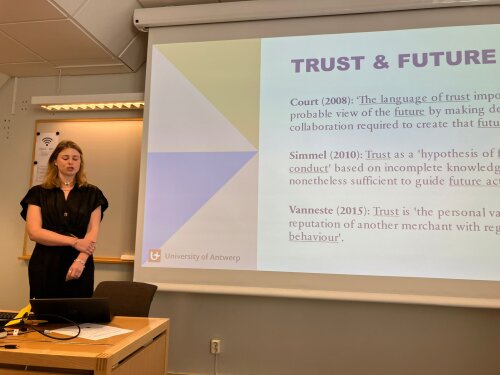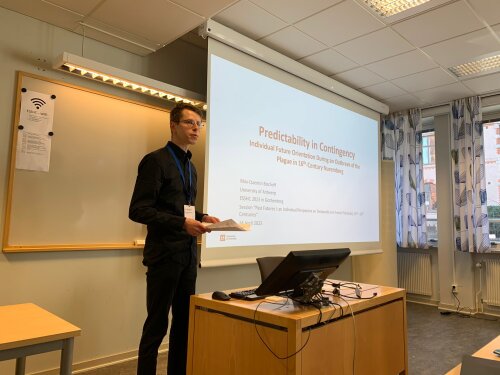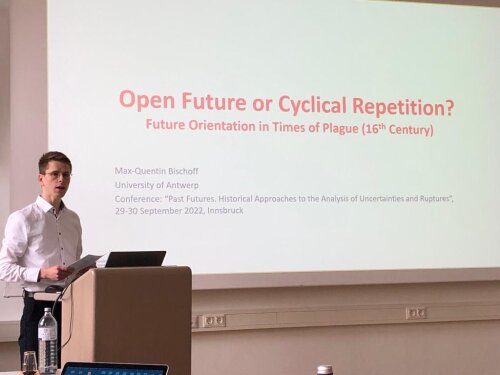Past Futures I : an Individual Perspective on Temporality and Future Practice(s)
Some of our team members presented their research at the European Social Science History Conference in Göteborg on the 14th of April 2023.
Jeroen opened the floor by introducing the project and placing it in the historiography of the history of the future.
Secularization of Future Thinking in Practice: a Comparison between English and French Merchant Letters (16th-18th Century)
Sara and Elisabeth presented their research on divine appeals in English and French letters between the 16th and 18th centuries to explore the concept of secularisation in future thinking of early modern merchants. They mapped secular and religious types of future thought in four French and English merchant correspondences. They showed that appealing to god in a letter was a choice and that divine appeals are not universally present in the letters. They also found that divine appeals became less uniform over time and arguably more of an individual choice. There was a substantial decrease in formulaic divine appeals for everyday business tasks like travel and trade, while prayer and resignation related to unpredictable events such as politics and war remained present throughout the correspondences. Their findings demonstrate that the conception of the future dominant in mercantile communities throughout the early modern period was pluritemporal at core.

The Foundation of a Joint Future: the Relation between Trust and Temporality in the Correspondence of the Dutch Merchant Claes van Adrichem, 1585–1597
Sanne's presentation connected the notions of trust and the future in the late-16th-century merchant correspondence of Claes van Adrichem. The use of implicit and explicit trust formulae in various future narratives proved critical in converting the desired future, as proposed by the merchant, into reality. Van Adrichem's factors in Danzig, his eyes and ears on the ground, were responsible for the latter. Using a typology based on the Latin subjunctive, Sanne looked specifically at the linguistic functions of the various future statements in the letters and concluded that only a limited number of functions were used for the trust formulae, namely promises, permissions, expectations and directives. Incidentally, in all the narratives, another important resounding instruction appears in addition to the trust formulae: the factor should carry out the instructions as profitably as possible. The various but finite amount of formulations echoes through the letters like a mantra, forming a common thread throughout the correspondence. Sanne’s paper showed how future-making is inherently linked to the discourse of trust in early modern merchant letters.

Predictability in Contingency. Individual Future Orientation During an Outbreak of the Plague in 16th-Century Nuremberg
Lastly, Max took a microscopic perspective on future orientation. Using letters written by members of the merchant family Tucher during an outbreak of the plague in Nuremberg in the year 1533, he discussed the historical experience of the plague between predictability and contingency: In 16th-century Europe, nobody was surprised by an outbreak of the plague anymore. Rather, it had become a part of life and was on the horizon of expectations. Still, however, it was a deadly disease and a disruption of everyday life. Anybody could get sick and die but when the plague broke out, the situation became highly contingent. Max argued that while the Tuchers largely refrained from making concrete predictions of how the plague would develop, they had a general pattern of wave-like development in mind that provided a guideline for their expectations and plans. Hence, the Tuchers did not just react to changed circumstances but they anticipated them and were prepared to act. Max found out that while everyday life and pure survival were fundamentally affected, this was hardly the case for their family trading company. They showed no sense of uncertainty regarding the future existence of their company; rather, the plague provided a minor disturbance. Plans were continued or designed without any consideration of the possible death of the company’s owners.

Open Future or Cyclical Repetition? Future Orientation in Times of Plague (16th Century) by Max-Quentin Bischoff
Max-Quentin presented his research in Innsbruck at the conference "Past Futures. Historical Approaches to the Analysis of Uncertainties and Ruptures" on the 29th and 30th of September 2022.
In his presentation he took a closer look at the future orientation during an outbreak of the plague in the 16th century. In early modern Europe, the plague was nothing new anymore but a part of the contemporaries’ lifeworld. At the same time it was, of course, still a rupture: However used people were to epidemic diseases, everyday life changed abruptly and significantly.
By analysing the extant letters of the merchant family Tucher written during the outbreak of the plague in Nuremberg in 1533, Max-Quentin focused on the relationship between notions of an open, unforeseeable future and stability or cyclical repetition, which render the future predictable and plannable. The Tucher letters provide insights into three domains of life: the plague itself, domestic life and trade. Each of these domains have their own temporal patterns and contingencies, and the temporality of the plague influences the temporalities of domestic life and trade in different ways.
Finally, Max-Quentin suggested an analytical distinction between three temporal structures that underlie our contemporary understanding of ‘crisis’ and discuss to what extent the concept of crisis can be applied to the early modern experience of an outbreak of the plague.
